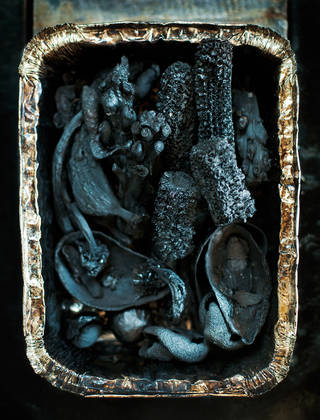Tokyo-based designer and maker Kosuke Araki creates beautiful tableware from carbonised food waste and traditional Japanese lacquer. His 'Anima' collection transforms food scraps that are often disposed of in landfills into elegant vessels that return the issue of waste to the table.
Working with food waste
While studying at the Royal College of Art, London, in 2013, Kosuke Araki embarked on a project to document food waste from local markets and shops, as well as his own kitchen, and to craft a material from it. The result was a series of bowls, Food Waste Ware, which were created through a process of carbonising vegetable waste to obtain a charcoal, mixing it with animal glue derived from discarded bones and skins, and moulding it into shape.

Araki's intention in developing this unusual material was to highlight the destructive approach that prevails in modern industrial societies towards the living world that sustains us.
For his second food waste collection, Anima, Araki kept a record of all the non-edible food waste produced in his house over a two year period, including rind, peel, shells and bones. The total amount weighed approximately 315kg.

This time he experimented with creating a powder from either dried or carbonised food waste and adding 'urushi', the sap from the urushi (or lacquer) tree that is used in traditional Japanese lacquer work. This provides both practical strength and an attractive sheen.
There is evidence that urushi has been used in Japan since the Stone Age as an adhesive, a material and a protective coating. Urushi craft also has a historical relationship with the meal. Traditionally leftover rice and tofu were mixed with the lacquer to adjust its viscosity and produce a stickier consistency. In turn, the natural lacquer had antibacterial properties, which made it suitable for serving food. The V&A holds many examples of lacquered tableware that enhanced the aesthetic qualities of Japanese cuisine, such as this 19th-century picnic set.

As a collection crafted entirely from food waste, Anima revisits this material history in the context of contemporary ecological concerns.

Why waste matters
In the US, UK and Europe, up to half of all food produced is wasted between farm and fork and never eaten, representing an enormous squandering of natural resources and energy. Meanwhile, vast quantities of non-edible food waste ends up in landfills, contributing to pollution and harmful emissions, instead of returning to natural cycles in the form of nutrients.
With Anima (meaning soul, spirit, life), Araki confronts the idea that we've ceased to appreciate the fact our food derives from valuable living matter. He writes:
Food is not a thing but life. We eat life for our existence. However, for lack of appreciation, we 'consume' life at a huge industrial scale…disposing of it in landfills.
He describes his process as a kind of ceremonial rite. Like the cremation of a body, the 'waste' is carbonised and reincarnated into something else. The careful transformation of food scraps into beautiful and precious objects is performed as a gesture of respect for the lifeforms that have been consumed.

As objects, the Anima vessels are both practical and poetic: you can eat and drink from them, but they are as much about nourishing new mindsets. Enjoying the formal beauty of the pieces only to discover they are made from something generally considered abject and disgusting (food scraps) creates a moment of surprise that challenges assumptions about the value of 'waste'. By making food waste tangibly present at the dinner table, the tableware prompts greater awareness of our collective habits of consumption and disposal, and the impacts they have. It is a material with a story that locates the eater within a wider food system.

Crafting a better future
Reflecting on his practice and priorities as a designer, Kosuke Araki identifies his 'client' as nature and talks about his hope that his projects can "help to reweave the relationship between nature and human beings". His perspective reflects a growing number of designers who are questioning established design approaches that place the consumer at the centre of everything, at the expense of the many human and non-human stakeholders involved in the lifecycle of a product. Anima, and projects like it, shift the role of the designer from designing things to crafting futures in which both people and the planet can flourish.
Three pieces from the Anima collection have been acquired by the V&A and can be seen in the exhibition FOOD: Bigger than the Plate (until 20 October 2019).




